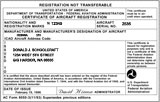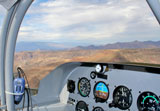|
Light-Sport Category AircraftOperating LimitationsOperating limitations are designed to fit the specific situation encountered. The FAA/DAR may impose any additional limitations deemed necessary in the interest of safety. The FAA/DAR will review each imposed operating limitation with the applicant to ensure they understand each operating limitation. The following operating limitations, as applicable, will be issued: (1) No person may operate this aircraft for any other purpose than that for which the aircraft was certificated. This aircraft must be operated in accordance with applicable air traffic and general operating rules of FAR 91 and all additional limitations prescribed herein. These operating limitations are a part of Form 8130-7 and are to be carried in the aircraft at all times and to be available to the pilot in command of the aircraft. (2) The pilot in command of this aircraft must advise the passenger of the special nature of this aircraft and that the aircraft does not meet the certification requirements of a standard certificated aircraft. (3) This aircraft must display the word “light-sport” in accordance with FAR 45.23(b). (4) This aircraft must contain the placards and markings as required by FAR 91.9. In addition, the placards and markings must be inspected for legibility and clarity, and the associated systems inspected for easy access and operation, to ensure they function in accordance with the manufacturer’s specifications during each condition inspection. (5) This aircraft is to be operated under VFR, day only, unless appropriately equipped for night and/or instrument flight in accordance with FAR 91.205, and when allowed by the manufacturer’s operating instructions. (6) Noncompliance with these operating limitations will render the airworthiness certificate invalid. Any change, alteration, or repair not in accordance with the manufacturer’s instruction and approval will render the airworthiness certificate invalid, and the owner of the aircraft must apply for a new airworthiness certificate under the provisions of FAR 21.191 with appropriate operating limitations before further flight. (7) Application to amend these operating limitations must be made to the responsible geographic FSDO or MIDO. (8) This aircraft does not meet the requirements of the applicable, comprehensive, and detailed airworthiness code as provided by Annex 8 to the Convention on International Civil Aviation. The owner/operator of this aircraft must obtain written permission from another Civil Aviation Authority (CAA) before operating this aircraft in or over that country. That written permission must be carried aboard the aircraft together with the U.S. airworthiness certificate and, upon request, be made available to an Aviation Safety Inspector (ASI) or the CAA in the country of operation. (9) The pilot in command of this aircraft must hold at least the appropriate category and class privileges, rating, or endorsements required by FAR 61. (10) No person may operate this aircraft in the light-sport category for compensation or hire except to tow a light-sport glider or an unpowered ultralight vehicle in accordance with FAR 91.309 or to conduct flight training. (11) This aircraft may only be operated in accordance with the manufacturer’s aircraft operating instructions, including any provisions for necessary operating equipment specified in the aircraft’s equipment list. (12) No person may operate this aircraft in the light-sport category for compensation or hire unless within the preceding 100 hours of time in service the aircraft has - - Been inspected by a certificated repairman with an LSA maintenance rating, or an appropriately rated mechanic, or an appropriately rated repair station in accordance with inspection procedures developed by the aircraft manufacturer or a person acceptable to the FAA, and has been returned to service in accordance with the applicable provisions of FAR 43; - Received an annual condition inspection in accordance with limitation (14); or - Received an inspection for the issuance of an airworthiness certificate in accordance with FAR 21. (13) Aircraft instruments and equipment installed and used under FAR 91.205 must be inspected and maintained in accordance with the requirements of FAR 91. Any maintenance or inspection of this equipment must be recorded in the aircraft maintenance records. (14) No person will operate this aircraft unless within the preceding 12 calendar months it has had a condition inspection performed in accordance with the manufacturer’s maintenance and inspection procedures, and was found to be in a condition for safe operation. As part of the condition inspection, cockpit instruments must be appropriately marked and needed placards installed in accordance with FAR 91.9. This inspection will be recorded in the aircraft maintenance records. (15) Condition inspections must be recorded in the aircraft maintenance records showing the following, or a similarly worded, statement: “I certify that this aircraft has been inspected on [insert date] in accordance with the manufacturer’s maintenance and inspection procedures, and was found to be in a condition for safe operation.” The entry will include the aircraft’s total time-in-service, and the name, signature, certificate number, and type of certificate held by the person performing the inspection. (16) No person may operate this aircraft in the light-sport category unless it is continuously maintained in compliance with FAR 91.327(b).
Back to the Light-Sport Aircraft Airworthiness Certification Page |









